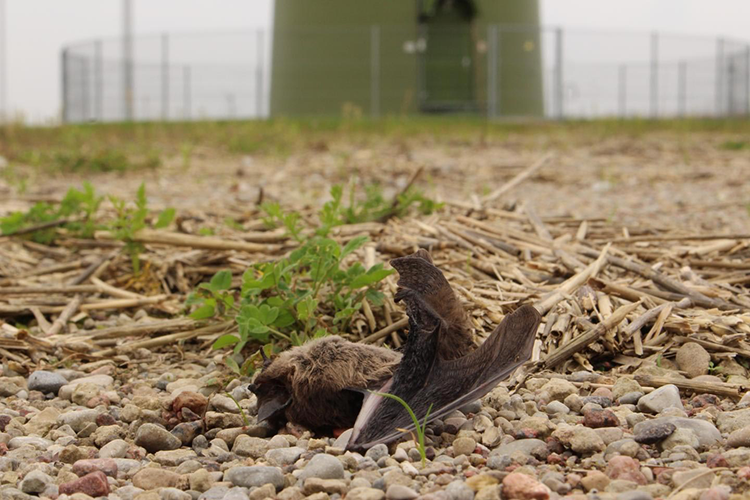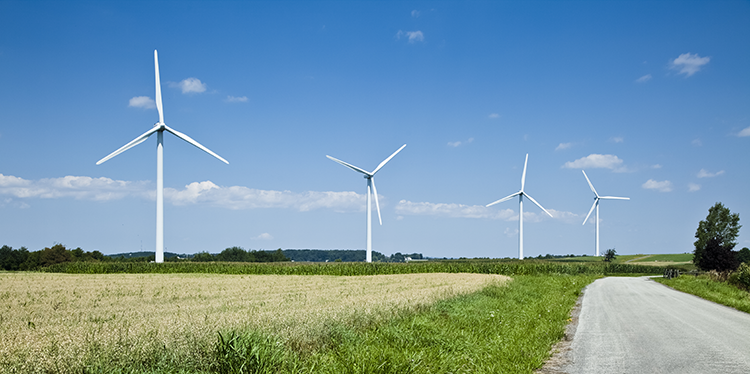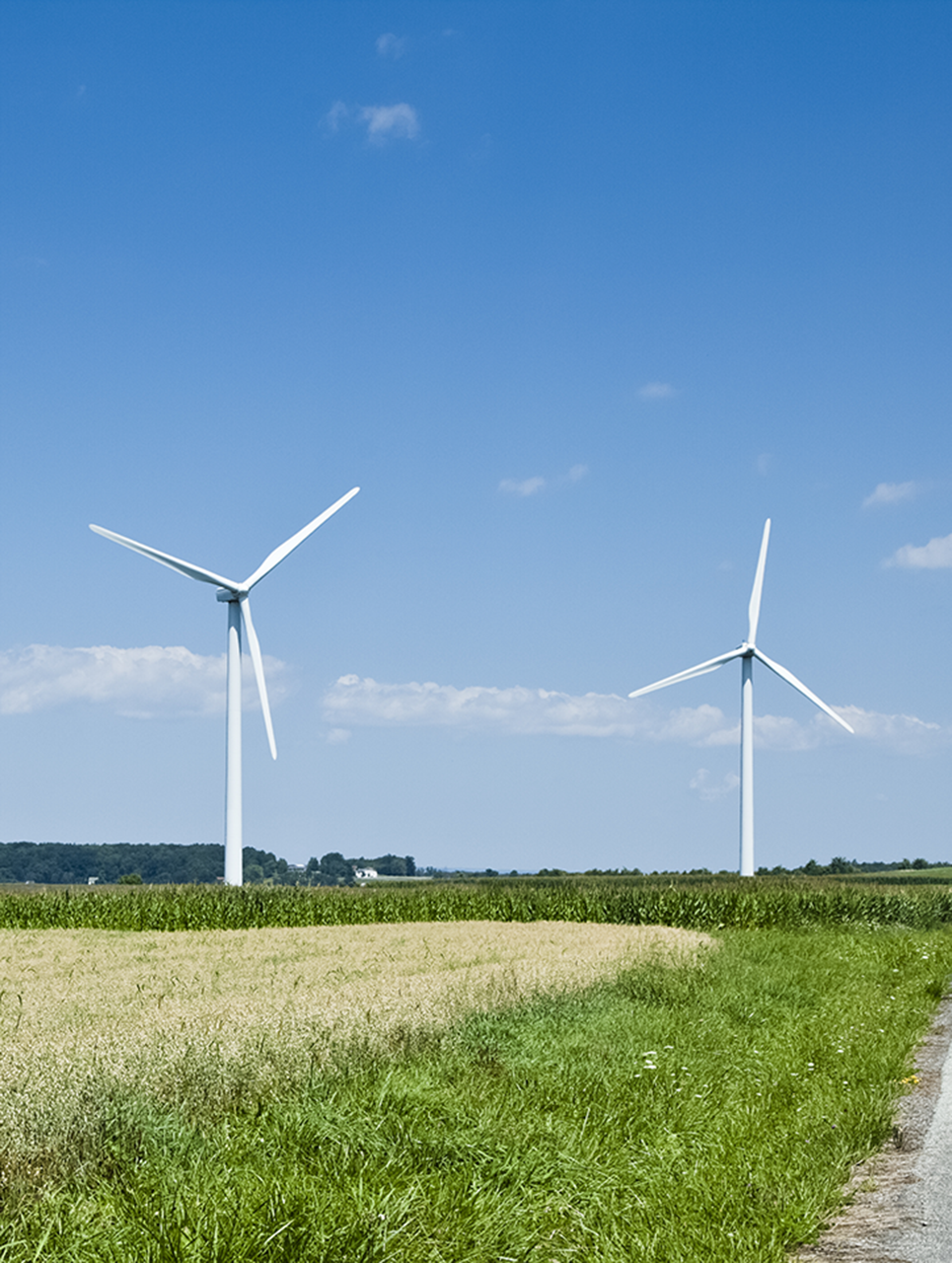Bats are small, delicate creatures, and wind turbines can be as large as half a football field long, reaching speeds of over 100 miles per hour. It’s not hard to guess the outcome when the two collide.
Unfortunately, they collide frequently. Studies of bats killed by wind turbines have found four to seven dead bats per megawatt of wind energy per year at large land-based wind installations. In 2020 the total land-based wind energy capacity of the United States hit 121,955 megawatts, according to the U.S. Department of Energy. Some quick arithmetic shows a total of 487,820 to 853,685 dead bats per year. And with wind power capacity rapidly increasing, the toll will rise.
They are killed by being hit by the blades, no question about that.”
— Ed Arnett, biologist and CEO of The Wildlife Society
The type of bat killed depends on where the turbines are, but the North American death toll is dominated by three species common in our part of the country: red bats, silver-haired bats and hoary bats.
Why exactly bats end up at wind farms is still a topic of research and debate. They might just be curious, they might be hunting for bugs near the turbines, and it might be love. Male bats can be attracted to large trees as landmarks in otherwise open space as sites to sing to attract females.
“At the end of the day the bats are dead and it may not matter why,” says Ed Arnett, biologist and CEO of The Wildlife Society. From 2004 to 2012 Arnett pioneered research into bats and wind turbines with the advocacy group Bat Conservation International. “They are killed by being hit by the blades, no question about that.”

And enough are getting killed to make a difference. A 2017 study using a computer model to predict the future of hoary bats found that deaths from wind turbines could cause their populations to drop by 90% in the next 50 years. “Our results suggest that wind energy development may pose a substantial threat to migratory bats in North America. If viable populations are to be sustained, conservation measures to reduce mortality from turbine collisions likely need to be initiated soon,” the authors wrote.
Fortunately, we know how to reduce the slaughter. Bats tend to hang around turbines and get hit by them at low wind speeds. Thus, as Arnett and other researchers figured out, feathering the blades of the turbines — turning them parallel to the wind so they stop rotating — at lower wind speeds on nights during migration can save bats. A 2021 review of studies of what is often called “curtailment” found that the practice could cut bat mortality by 63%.
Wind turbines generally don’t produce power below a certain “cut-in” wind speed, even though the blades might still rotate. It is relatively easy for turbine operators to feather blades below cut-in speed, but the top of the range of wind speeds for which bats need protection can overlap with the cut-in speed, forcing a clash between bat protection and energy production.
Bat deterrent devices, which blast the bat equivalent of white noise in an attempt to make it difficult for them to navigate by echolocation and thus discourage them from hanging around, have had mixed results. A 2016 study found that the devices did not reduce the number of bats killed by turbines, and actually seemed to increase the number of red bats killed.
In Pennsylvania, wind operators appear to be complying with a cooperative agreement with the state, in which, among other measures, they curtail operations on nights when bats are likely to be most active. “Pennsylvania took a hard stand with its cooperative agreement,” Arnett said.

“So far, about 40 facilities statewide have signed the agreement. The agreement is voluntary, but most facilities follow the measures,” says Travis Lau, communications director for the Pennsylvania Game Commission (PGC). “The PGC also requests adjustments be made to wind turbine speed to reduce mortality.”
Outside of Pennsylvania, it is unclear how many wind farms curtail operations to save bats. The wind energy industry adopted voluntary measures to reduce bat mortality in 2015, but no one seems to know how many companies are actually adopting the measures. I asked Michael Whitby, the director of the Bats and Wind Program at Bat Conservation International, how widespread curtailment is in the wind power industry today. “We have no information on that,” he said. The voluntary practices also let turbines cut in at low enough speeds to keep killing a lot of bats.
A publication by the industry-backed Renewable Energy Wildlife Institute implies that the commitment to protecting bats does not extend very far. “To be implemented effectively, technologies designed to minimize wildlife impacts during wind facility operation need to be able to do so without adversely affecting turbine performance or maintenance requirements.” Protecting wildlife is fine, as long as it doesn’t touch the bottom line.
The Renewable Energy Wildlife Institute did not reply to multiple requests for information on how widespread curtailment is, and three wind operators I contacted about their practices did not reply.
“There really hasn’t been broad implementation of curtailment,” Arnett says. “This industry has known about this issue for a long, long while — 15 years of info coming in — so to build a facility and not factor this in is poor planning.”
Wildlife advocates who want to push back in any way against the wind power industry walk a rhetorical tightrope. On one side the cause of bats and other wildlife is taken up disingenuously by people who oppose wind power on aesthetic “NIMBY” grounds as well as by fossil fuel backers, like Donald Trump. On the other hand, any compromise to protect wildlife can be dismissed by environmentalists as standing in the way of the fight against global warming, even though that framing ignores the option of conserving energy.
The expansion of renewables entails the industrialization of vast swaths of wildlife habitat. This is true of wind farms, of Southwestern solar projects that kill desert tortoises and could fragment habitat for larger animals like pronghorn antelope, not to mention proposals to clear forests for arrays of solar panels.
The environment has taken a hit from every energy revolution to date: whale oil, water power, nuclear, and, of course, fossil fuels. Though wind helps solve one set of problems, it creates others. It is possible to protect wildlife and expand the use of renewable energy, and it is incumbent on those of us who support both to demand that we avoid the mistakes of the past.











Thanks for this article. With bats already dying in large numbers from white nose syndrome, it upsets me that humans are creating another threat for so many of them. Wildlife protection should be built into this new industry with regulations, not voluntary agreements.
I’ve heard about bladeless wind mills, but no one seems to be using them in the US. It seems like they would be much safer for birds and bats.
Of course, as the article mentions, all energy production harms wildlife, and the environment, so energy conservation should be number one priority.
I have read that bats and birds are killed by windmills not so much by being struck, but by the pressure wave they generate destroying their lungs. This would seem to be a much more difficult problem than stopping direct strikes..
Whichever the direct mechanism, we’ve got studies showing that curtailment of the turbines is effective at reducing the mortality .